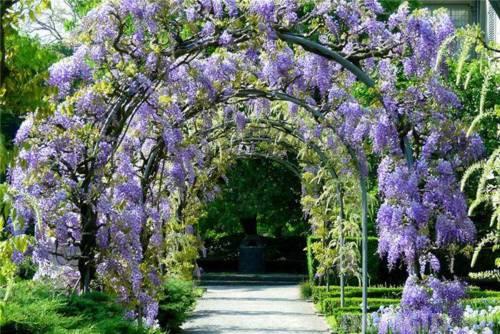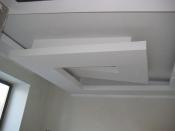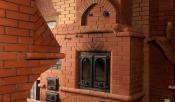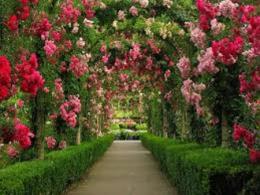Search
Login
Recommended
DIY Pergola, construction technology
To decorate a suburban area, decorative elements of various types are often used today. Framed by beautiful flowering flowering plants, or just lush greenery, arches and trellises, awnings, arbors and pergolas look extremely picturesque. They are arched structures that have recently been increasingly used in creating garden designs. Initially, the word pergola was used for canopies and extensions, but today's fashion suggests placing the pergola as a separate building. By design, the pergola is an openwork corridor of vertically mounted supports, arches, horizontal fragments.
Content:
- Design features
- Types of Pergolas video
- Pergolas in landscape design - what rules to follow when choosing
- DIY Pergola Construction
- How to process a tree and plant plants video
Pergola design features
A traditional pergola is a series of arches located close to each other and connected by a trellised ceiling. The openwork, graceful form of such a structure allows you to decorate the paths leading to the garden. If the first pergolas that the Romans built were intended solely to support the vine, today pergolas surprise with a variety of solutions and options, both execution and use of the countryside in landscape design.

The principle of constructing classical pergolas has been observed in our time, but their purpose in the design of the landscape has changed somewhat - most often they serve to separate garden areas and at the same time combine them, creating a decorative transition from one to another.

If in the old days pergolas were built to support the vine, today they are decorated with beautiful ampelous plants with beautifully climbing twigs, such as:
- clematis,
- honeysuckle,
- tuberose
- actinidia
- nasturtiums
- morning glory.
To give the lattice structure a special appeal, you will need to choose the right plants, place them in hanging pots.

Depending on the style of the garden, the pergola can be made of different materials, for example, logs of deciduous trees would be the ideal material for a rustic style, and materials for a noble garden landscape would need more expensive materials - natural oak and natural stone.
Pergolas can be classified according to different qualities, for example, the form of structures can be:
- rounded
- with kinks
- classic.

Material for the manufacture of arches and gratings can serve:
- metal,
- a rock,
- wood,
- plastic.

The location option may be different:
- as an independent structure,
- in combination with a fireplace or stove,
- as a decoration for a garden bench or swing,
- pergola arches can serve as a complement to the entertainment complex - the stage or the auditorium.
To implement the original spatial solutions, designers resort to the construction of several pergolas that divide the garden areas located next to each other at different angles or with small gaps.
The functions assigned to arched garden structures can also be different, arches can serve:
- a support for climbing shrubs and liana-shaped plants,
- as a protective structure from the sun,
- a comfortable green corner for a relaxing holiday,
- garden decoration.
Types of Pergolas
Most often, the owners of suburban areas resort to the construction of metal or wooden pergolas, often representing a canopy attached to the house. Such a structure can serve as a playground for children, a gazebo, summer kitchen, shelter for a car. The disadvantage of such a structure is that it will not be able to protect from heavy rain.

The pergola-screen will serve as a reliable shelter from prying eyes, it is often built along the fence. Such a pergola in the landscape will serve to delimit the territory, with its help it is perfectly possible to separate completely incompatible sections, for example: a regular garden and a sports ground with modern equipment. Pergolas for climbing plants can also have the form of a screen; this type of pergola is suitable for climbing roses and grapes.

Shade windows on the south side of the house will help pergola-visor. A pleasant penumbra above the garden path will create a pergola tunnel, beautifully decorated with curly flowers, it will give the garden notes of romanticism.
About how beautiful pergolas look in the garden and on the site we watch the video:
Pergolas in landscape design - what rules to follow when choosing
Since the pergola is designed to decorate the garden, or places of rest in the garden, its appearance should delight the eyes with its aesthetics and lightness. At the same time, it should be strong enough and reliable.

The dimensions of the structure must necessarily correspond to the size of the site - it is not recommended to build a very small pergola on a large area - it will simply be lost, a large arch system will clutter up a small area. Since living plants will be weaving on arches, their weight will increase with age - the structure must have an appropriate margin of safety.

Taking into account the sailing structure also have to be considered - the recommended height of the structure should not exceed 2.5 m.
When constructing a pergola, serious errors should not be allowed, if in the summer its construction is covered with greenery and flowers, then in winter all defects will be visible and the structure will have to be reconstructed.
If a wooden pergola is to be constructed, then all its fragments will need to be treated with high-quality antiseptics. Pergolum metal elements are treated with anti-corrosion agents.
DIY Pergola Construction
If you have the skills to work with wood or welding, then you can make a pergola yourself, from improvised materials. Also, the arched structure can be bought ready-made, or ordered its manufacture from any material in accordance with the developed project.

Before proceeding with the design, you will need to solve the issue of the functionality of the object and determine the exact location on the territory.
For decorative purposes only, you can build a pergola near the footpath. A more practical option would be the construction of a pergola-arbor, it can accommodate tables and benches for relaxing, barbecue, swings for children. As an open kitchen-dining room can serve as a pergola adjacent to the house.

It will be necessary to decide which form of pergola fits best into the garden composition. The lines of the structure can be strict - straight or broken, or, conversely - round, fan-shaped.
preparatory work

At the preparatory stage, you will need to prepare:
- a sufficient amount of materials
- relevant tools
- fasteners.
For example, consider the construction of a wooden structure. Soil at a construction site needs to be well leveled. Next, a breakdown is made on the terrain of the dimensions of the structure and a trench is excavated along the entire perimeter. The depth of the trench is from 25 to 30 cm. The foundation is poured with concrete, after the mortar hardens the wall is erected, which will serve as the base. It will be enough to drive it to a height of 0.4 m.
foundation pouring and installation of supports
The wooden grid supports of the future structure can be installed directly into the foundation.

You can install the side supports when laying the foundation. To protect wooden elements from moisture, microorganisms and fungi, it will be necessary to impregnate the slats with antiseptics, and tightly wrap the ends immersed in the soil in ruberoid or treat it with melted bitumen.
If the installation will be carried out on an existing concrete site, you will have to make markings, install metal anchors in the locations of the supports. A sufficiently strong fastening can be obtained using anchor bolts. After anchoring, each structural element must be carefully checked according to the level - the errors made will ultimately lead to a skew of the structure.
installation of support beams

Recommended dimensions of the supporting elements:
- width - 15 cm
- thicknesses - not less than 5 cm,
- length - in accordance with the planned length of the finished structure.
To cut the beautiful curly edges of the beams, it is best to make a pattern. The support beams are fastened to the support elements installed in the foundation using self-tapping screws from 8 to 10 cm long. The beams are fixed in turn, checking the correct installation using the level.
installation of cross beams
For the manufacture of transverse beams using bars of the same length as for supporting. But they will need to be prepared: cut out the grooves for the entry of the supporting elements. It should be cut carefully, with exact adherence to the dimensions; an electric jigsaw or a circular saw can be used as a working tool. Fixture of cross beams is carried out with the set step.

To give structural elements a more aesthetic appearance, they are decorated with decorative overlays. But a well-crafted tree in garden design will also look quite interesting, in addition, in the summer it will be decorated with bright greenery. On each of the poles, installation of diagonal struts will be required. if you make them carefully and according to the template, then they may well serve as decorative elements.
On top of the transverse beams, you will need to install crossbars with pre-prepared grooves. Fasteners are made with self-tapping screws. To decorate the pillars, if desired, you can use the lining.
On this, the process of constructing a wooden arch is completed, then you can proceed to decorate the product.
Watch a video about building a pergola with your own hands:
How to process a tree and plant plants
The construction process must necessarily end with the processing of wood with antiseptics and the opening of its surface with varnish.
You should consider in advance which plants to plant for landscaping. Naturally, they should be:
- curly
- have decorative leaves
- bloom over a long period.

In addition to flowers, you can plant grapes or actinidia, roses, buy seedlings or seeds of various beautiful plants is not a problem today. We should not forget that the decorativeness of a pergola depends entirely on the attractiveness of the plants that will be planted near it.
To create a laconic landscape, another option is used - the structure is painted in beautiful colors, or the wood is left in its original form, having opened it with varnish. The decoration of such pergolas can be an original form, a beautiful carving or forging.
Building a pergola with your own hands is not a very complicated process, a creative approach to solving the issue will create a unique structure that will become a real decoration of your garden.
We look at another version of the construction of the pergola:





